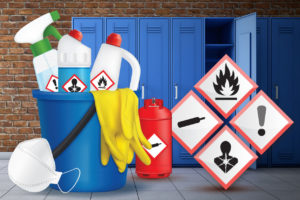November 16, 2020
Chemical safety tips for your employees
Since COVID-19, cleaning and disinfecting have become a larger part of many employees’ days.
As a result, many employees have a higher exposure to chemicals on the job than they did in the past.
Some who rarely or never used chemicals as a part of their daily work before, like teachers, may find themselves using them multiple times a day. And those who have used chemicals in the past, like janitorial staff, may now be using new, stronger chemicals with different safety considerations.
Use these chemical safety tips to keep these employees safe by providing them with training and personal protective equipment tailored to the specific chemicals that they’re using.
Chemical safety basics
Conversations on chemical safety often start by discussing common ways chemicals can get into the body, such as ingestion, absorption (skin or eye contact), inhalation (breathing in) and injection.
This explains why proper personal protective equipment, like gloves and masks, is so important. They offer protection from chemicals that can cause skin and lung irritation.
For example, employees who are spraying powerful disinfectants may need to wear masks so they don’t inhale the chemicals, and cover their skin to prevent irritation.
Every chemical is different, and even chemicals that are used for the same purpose can pose different safety hazards. You can find information on the hazards posed by any particular chemical by reviewing its chemical Safety Data Sheet (SDS), which is provided by the manufacturer.
Knowing the pH level of a chemical, and its impact on safety can also help. Weak acids and bases/caustics can dry out and irritate skin, whereas strong acids and bases/caustics can cause severe, corrosive chemical burns.
Knowing how to read the hazard communication pictograms on the labels, and training your staff on this is also important.
Training your employees
Training employees to safely use any chemicals they may be exposed to in the course of work is not only the right thing to do, it’s required.
All states require chemical safety training before use, and some states have additional requirements beyond that. Check the Occupational Safety and Health Administration guidelines in your state.
When you train your employees in chemical safety, be sure to cover the following points:
- Which chemicals are used in their work areas
- The primary routes by which chemicals can enter the body: inhalation, ingestion, absorption and injection
- How to understand the labels on chemical containers, including the nine internationally recognized pictograms
- Where to find chemical Safety Data Sheets (SDSs) in the workplace, and how to understand them (including a review of the information contained on the SDSs of any chemicals they will be working with)
- Location of emergency eyewashes, first aid kits, etc.
- How to properly store hazardous chemicals
- Required personal protective equipment and how to properly use and wear it
- How to dispose of chemical waste properly
- Don’t eat, drink or smoke while using chemicals, as these put you at risk of ingestion injuries
- Don’t mix chemicals if you’re unsure how they will react
- Clean up spills promptly
For more information on chemical safety see our Employee Right-to-know and Chemical Safety – Understanding Chemical pH 5-Minute Solutions safety talks, available on sfmic.com.





